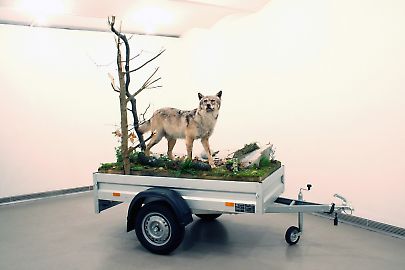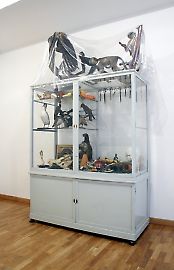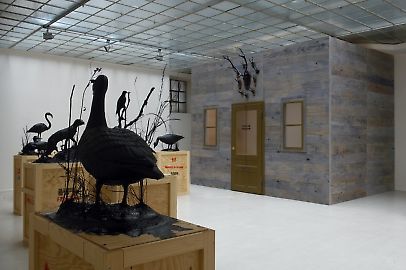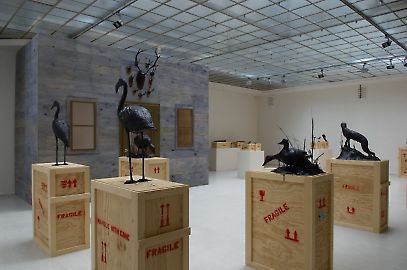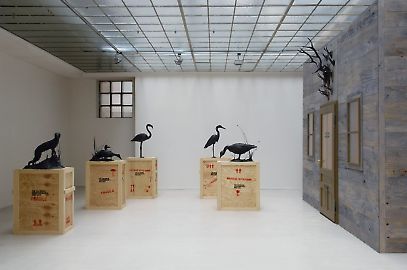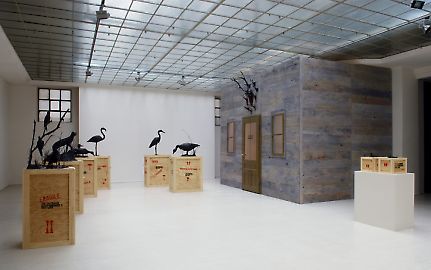Mark Dion -- The Tar Museum
Standing at the core of Mark Dion's work is a concern with nature and its representation, which he critically analyzes as a cultural construction. The artist, born in the US in 1961, is fascinated by differing conceptions of nature, often turning to the historical juncture of the late seventeenth and early eighteenth centuries, when the subjective order of cabinets of curiosities was supplanted by the scientific orientation of the museum common today. In realizing his works, Dion takes recourse to methods and techniques from science and archaeology: he collects, archives, orders, and compares. Despite their apparent proximity to scientific discourse, however, Mark Dion's installations and ensembles of found pieces and prepared samples precisely do not represent a natural history collection, but rather are reflections on systems of order and collecting. In essence, the artist always asks how we develop our notion of nature. According to his point of view, the taxonomies we use to explain natural processes say more about social and political ideologies than about nature itself. His genuine interest is thus not so much academic, but rather ecological and political.
Collecting, archiving, and classifying as natural scientific methods transfer artifacts and natural phenomena to new contexts, whereby they on the one hand lose their function in the context of their original emergence, on the other hand being freed for critical reflection.
The Tar Museum, the current exhibition at Galerie Georg Kargl, represents a further development of the vocabulary used by the artist in two previous presentations at Galerie Metropol (1994) at Galerie Georg Kargl (2001).
In the central exhibition space, the glazed courtyard of the gallery, tarred large birds, like geese and flamingos, are exhibited on top of their respective transport boxes. Tar is a black, viscous mixture, black to brown in color, that consists of organic compounds; it is obtained by the heat induced decomposition of organic natural materials, such as crude oil. For Mark Dion, this substance, which, despite its organic origins, kills and destroys all living material, even microorganisms, represents the radical opposite to the nutrient fat, which provides energy for man and animal alike. Tar is for Dion a symbol for the functional transformation of materials used for profit-oriented industrial processes and altered by way of biotechnology.
This part of the exhibition points to the destructive and violent side of the appropriation of nature: "They are not just stuffed animals...but are covered in tar. The mark of violence is quite concrete, a violence the visitors would think nothing about if the animals could be seen posed naturally."(1) A form of beholding nature that in its radicalness makes clear that "what was thought to be observation of life was actually the study of death."(2)
Again and again, Dion in particular questions the forms of representation used in museums of natural history. He understands them as places where scientific findings are presented to a broad public as "truths" of natural phenomena, which do not correspond to the actual course of nature. "To me the museum embodies the 'official story' of a particular way of thinking at a particular time for a particular group of people. It is a time capsule."(3) The Ruins of the Museum emphasizes this subjective aspect of the presentation of collections, and thus the transitory nature of their veracity. In this work, a collection of natural products and artifacts is presented in display cabinets familiar from the cabinets of curiosities from the eighteenth century: but here, they already show signs of decay and destruction.
The mobile diorama Mobile Wilderness Unit also reemerges in Tar Museum, this time in the form of a wolf in a kind of display cart. Until the development of agriculture and grazing, the wolf was the most widespread predator on the planet, with a natural habit that stretched from all of Europe and Asia to North America. In wide parts of this huge expanse, especially in Western Europe and North America, the species was driven to near extinction by man. Behind this work lies the idea of being able to transfer an essence of wilderness into a social sphere—that is, back to nature—instead of into the closed environment of a museum.
The result of Mark Dion's artistic reflections are spatially expansive installations, staged like backdrops, that often integrate site-specific history and culture. With surprising thematic linkages and an ironic-allegorical power of reflection, Mark Dion analyzes the political, economic, and aesthetic forces behind the social representation of nature at the gateway between science and art. Text: by Linda Klösel
(1) Dieter Buchhart, "Meine Werke sind nicht über Natur, sondern über die Idee von Natur: Interview mit Mark Dion," Kunstforum 157 (2001), pp. 185-197
(2) "Miwon Kwon in Conversation with Mark Dion," in: Dion (1997) d., p. 22.
(3) Ibid., p. 17.



